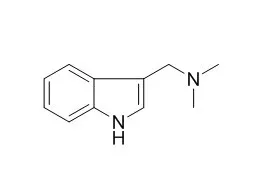| In vitro: |
| Chemosphere. 2014 Jun;104:212-20. | | Natural xenobiotics to prevent cyanobacterial and algal growth in freshwater: contrasting efficacy of tannic acid, gallic acid, and gramine.[Pubmed: 24332729] | Allelochemical action against planktonic phototrophs is one central issue in freshwater ecology and quality management.
METHODS AND RESULTS:
To determine some basic mechanisms of this toxic action, we exposed the coccal green alga, Desmodesmus armatus, and the coccal cyanobacterium, Microcystis aeruginosa, in a batch culture well-supplied with carbon dioxide to increasing concentrations of the polyphenols tannic acid and gallic acid and the alkaloid Gramine. The phototrophs were checked after 2d and at the end of the culture for biomass-based growth rates, cell volume, maximum quantum yield of photosystem II (ΦPSIImax), chlorophyll a content (chla) after 2d and at the end of the culture, and lipid peroxidation only at the end of the culture. During the culture, the pH rose from 7.64 to 10.95, a pH characteristic of eutrophic freshwater bodies during nuisance algal blooms. All xenobiotics reduced the growth rate, ΦPSIImax, and chla during the first 2d with M. aeruginosa being more sensitive to the polyphenols than D. armatus. The efficacy of the polyphenols declined with increasing pH, indicating potential polymerization and corresponding reduced bioavailability of the polyphenols. In contrast to the polyphenols, Gramine increased its toxic action over time, independent of the prevailing pH. All exposures caused slight to severe lipid peroxidation (LPO) in the phototrophs. Hence, one mechanism of growth inhibition may be oxidative stress-mediated reduction in photosynthesis.
CONCLUSIONS:
The presented results suggest that in successful field trials with leachate, the prevailing environmental conditions may inactivate polyphenols and xenobiotics other than polyphenols may be more effective. | | Plant Cell Physiol. 2001 Oct;42(10):1103-11. | | Gramine increase associated with rapid and transient systemic resistance in barley seedlings induced by mechanical and biological stresses.[Pubmed: 11673626] | Systemic acquired resistance (SAR) is one of the intriguing issues for studying the mechanism in signal transduction system in a whole plant. We found that SAR and increase of an antifungal compound were induced rapidly and transiently in barley (Hordeum vulgare L. cv. Goseshikoku) by mechanical and biological stresses. One of the major antifungal compounds was identified as an indole alkaloid, Gramine (N,N-dimethyl-3-aminomethylindole), by mass spectrum and NMR analyses.
METHODS AND RESULTS:
Gramine is well known as a constitutive compound of barley, but it increased significantly in the primary and secondary leaves of barley seedlings within 12 h after pruning or inoculating with the powdery mildew fungi of barley (Blumeria graminis f.sp. hordei) and wheat (B. graminis f.sp. tritici). However, in the leaf detached from unwounded seedlings or in the leaf inoculated with the barley powdery mildew fungus, Gramine did not increase at all. In the water droplets contacted with barley leaves, the amount of leaked Gramine increased dependently upon the time after the seedling was injured mechanically. We also found a tight correlation between Gramine increase and enhancement of resistance to the barley powdery mildew fungus in barley leaves treated with an endogenous elicitor. Furthermore, such a systemic resistance was not observed in a barley cultivar Morex that lacks the biosynthetic pathway of Gramine.
CONCLUSIONS:
From these results, we conclude that Gramine is the excellent marker in rapid and transient systemic acquired resistance in barley. |
|
| In vivo: |
| Steroids. 2015 Jun;98:92-9. | | Synthesis, spectroscopy, theoretical and biological studies of new gramine-steroids salts and conjugates.[Pubmed: 25777948] |
METHODS AND RESULTS:
New Gramine connections with bile acids (lithocholic, deoxycholic, cholic) and sterols (cholesterol, cholestanol) were synthesized. The structures of products were confirmed by spectral (NMR, FT-IR) analysis, mass spectrometry (ESI-MS) as well as PM5 semiempirical methods. Unexpectedly, the products of the reaction of Gramine with cholesterol and cholestanol were symmetrical compounds consisting of two molecules of sterols connected by N(CH3)2 group. All new synthesized compounds interact in vitro with the human erythrocyte membrane and alter discoid erythrocyte shape inducing stomatocytosis or echinocytosis. Increase in the incorporation of the fluorescent dye merocyanine 540 (MC540) into the erythrocyte membrane indicates that new compounds at sublytic concentrations are capable of disturbing membrane phospholipids asymmetry and loosening the molecular packing of phospholipids in the bilayer. Gramine significantly decreases the membrane partitioning properties as well as haemolytic activity of lithocholic acid in its new salt. Moreover, both deoxycholic and cholic acids completely lost their membrane perturbing activities in the Gramine salts. On the other hand, the capacity of new Gramine-sterols connections to alter the erythrocyte membrane structure and its permeability is much higher in comparison with sterols alone.
CONCLUSIONS:
The dual effect of Gramine on the bile acid and sterols cell membrane partitioning activity observed in our study should not be neglected in vivo. |
|






 Cell. 2018 Jan 11;172(1-2):249-261.e12. doi: 10.1016/j.cell.2017.12.019.IF=36.216(2019)
Cell. 2018 Jan 11;172(1-2):249-261.e12. doi: 10.1016/j.cell.2017.12.019.IF=36.216(2019) Cell Metab. 2020 Mar 3;31(3):534-548.e5. doi: 10.1016/j.cmet.2020.01.002.IF=22.415(2019)
Cell Metab. 2020 Mar 3;31(3):534-548.e5. doi: 10.1016/j.cmet.2020.01.002.IF=22.415(2019) Mol Cell. 2017 Nov 16;68(4):673-685.e6. doi: 10.1016/j.molcel.2017.10.022.IF=14.548(2019)
Mol Cell. 2017 Nov 16;68(4):673-685.e6. doi: 10.1016/j.molcel.2017.10.022.IF=14.548(2019)